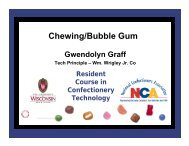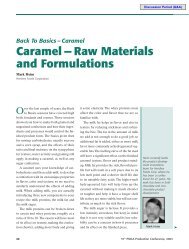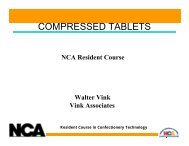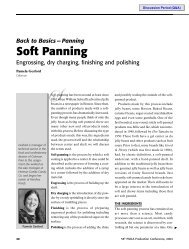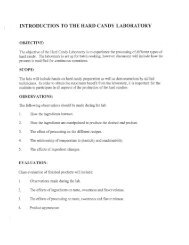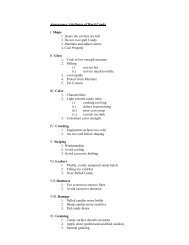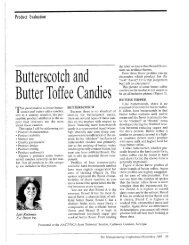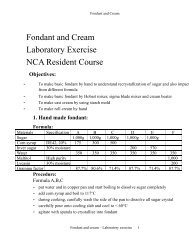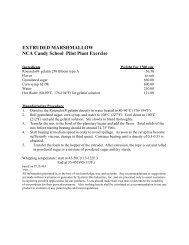2001 Grained and Ungrained Confections - staging.files.cms.plus.com
2001 Grained and Ungrained Confections - staging.files.cms.plus.com
2001 Grained and Ungrained Confections - staging.files.cms.plus.com
You also want an ePaper? Increase the reach of your titles
YUMPU automatically turns print PDFs into web optimized ePapers that Google loves.
syrup in the finished product are below 75<br />
percent. Because this recipe is unstable a<br />
small quantity of sorbic acid or potassium<br />
sorbate is added to inhibit mold growth.<br />
The higher the sugar content of fondant,<br />
the higher the water activity, with the<br />
greater danger of mold growth <strong>and</strong> yeast<br />
fermentation. This is why you sometimes<br />
find black spots of mold on the surface <strong>and</strong><br />
inside high-sugar fondants. This will not<br />
happen with a 3:2 fondant using st<strong>and</strong>ard<br />
42 de corn syrup.There are many ways of<br />
eliminating this using the newer corn syrups<br />
<strong>and</strong> incorporating ingredients that lower<br />
water activity, such as sorbitol or glycerol.<br />
Making Fondant<br />
Making fondant can be broken down into<br />
a number of steps as shown in Figure 8.<br />
Essentially, the cooking temperature controls<br />
the final moisture content of the fondant<br />
<strong>and</strong> must be controlled accurately,<br />
including <strong>com</strong>pensating for the effect of<br />
atmospheric pressure on the cooking temperature,<br />
cooking higher on dry days when<br />
the pressure is high <strong>and</strong> lower on wet days<br />
when the pressure is low.<br />
Figure 9 shows a typical cooking-temperature<br />
<strong>com</strong>pensation chart for a sugar<br />
syrup, indicating the cooking temperature<br />
required for a specific water content.<br />
The crystallization temperature <strong>and</strong> the<br />
mixing or shear rate control the size distribution<br />
of the sugar crystals. In general,<br />
the higher the syrup temperature when it is<br />
mixed to cause sugar to crystallize, the<br />
larger the crystals produced. Generally,<br />
also, the faster the syrup is mixed, the<br />
smaller the crystals.<br />
When you make fondant either by h<strong>and</strong><br />
or by machine, there is not just one size of<br />
sugar crystal produced but a whole range.<br />
The sugar crystals, in addition to sweetness,<br />
contribute texture <strong>and</strong> surface area,<br />
which considerably govern the viscosity of<br />
the fondant <strong>and</strong> affect its use. The human<br />
<strong>Grained</strong> <strong>and</strong> <strong>Ungrained</strong> <strong>Confections</strong><br />
Steps for the Manufacturing<br />
of Fondant<br />
Water<br />
Sugar<br />
Corn syrup<br />
Syrup making<br />
moisture content<br />
75–78%<br />
Cooking to<br />
control moisture<br />
content 12/14%<br />
Cooling<br />
115˚—190˚F<br />
High shear<br />
mixing to<br />
crystallize syrup<br />
To store or next<br />
process<br />
Figure 8<br />
Barometric Pressure<br />
Accurate recipe weighing.<br />
Proper dissolving of<br />
sugar before<br />
adding corn syrup.<br />
Cooking temperature<br />
<strong>com</strong>pensated for<br />
atmospheric pressure.<br />
Final moisture of syrup.<br />
Temperature cooled<br />
down to, without<br />
agitation or<br />
precrystallization.<br />
Crystallizing<br />
temperature.<br />
Flow of cooling water<br />
to keep this at required<br />
temperature.<br />
Mixing speed.<br />
Storage temperatures<br />
<strong>and</strong> RH<br />
(normally 100˚F <strong>and</strong><br />
65% RH)<br />
palette can only detect particles greater in<br />
size than 12–16 microns. Below this all particles<br />
taste smooth, just like water. Bigger<br />
particles control the detectable texture of<br />
the product. When they reach 50 microns<br />
<strong>and</strong> above, they start to be<strong>com</strong>e s<strong>and</strong>y <strong>and</strong><br />
too coarse to be pleasant. Generally, fon- ➤<br />
The human palette<br />
can only detect<br />
particles greater in<br />
size than 12–16<br />
microns, below this<br />
all particles taste<br />
smooth, just like<br />
water.<br />
in inches<br />
Moisture<br />
Content 29.42°F 29.67°F 29.92°F 30.17°F 30.42°F 30.67°F 30.92°F<br />
14% 236.5 236.8 237.2 237.6 238.2 238.5 239.0<br />
13% 238.8 239.1 239.5 240.0 240.5 240.8 241.3<br />
12% 240.8 241.2 241.5 242.0 242.4 242.8 243.4<br />
11% 243.1 243.5 244.0 244.4 244.8 245.8 246.2<br />
10% 245.8 246.2 246.6 247.0 247.5 248.0 248.5<br />
9% 248.6 249.0 249.5 250.0 250.5 251.0 251.4<br />
8.5%<br />
Figure 9<br />
250.1 250.5 251.0 251.5 251.9 252.4 252.8<br />
55 th PMCA Production Conference, <strong>2001</strong> 47



